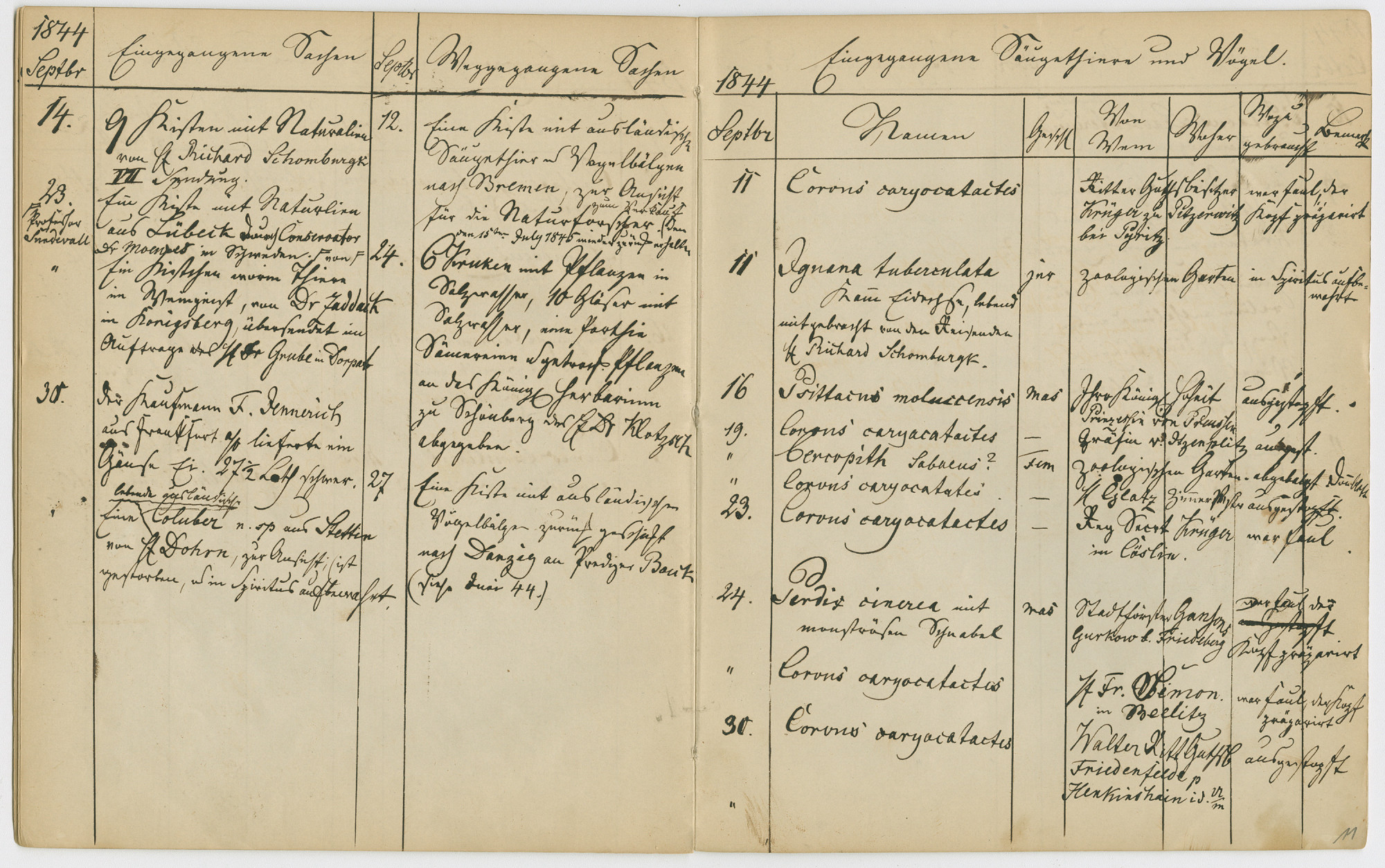
Notebook of the animal preparator Friedrich Beyer at the Berlin Zoological Museum that records the arrival of a green iguana on 11 September 1844 as well as its provenance and how it was prepared. (MfN, HBSB, ZM S I Verwaltungsakten, Tagebuch Beyer, 1844. All rights reserved.)
On September 11, 1844, Friedrich Beyer, animal preparator at the Berlin Zoological Museum, recorded in his  notebook the arrival of a green Iguana tuberculata (now Iguana iguana) from the Zoological Garden, which had been “imported live by the traveller Mr. R. Schomburgk”.
notebook the arrival of a green Iguana tuberculata (now Iguana iguana) from the Zoological Garden, which had been “imported live by the traveller Mr. R. Schomburgk”.
In fact, the botanist Schomburgk had spent nearly four years travelling through the former colony of British Guyana to collect  specimens. On his journey, he had sent back numerous crates filled with dried plants, skeletons, and animals preserved in alcohol to the Zoological Museum and the Botanical Garden in Berlin. But when he heard that a zoo would soon open in the city, he also began collecting living animals for the Zoological Garden.
specimens. On his journey, he had sent back numerous crates filled with dried plants, skeletons, and animals preserved in alcohol to the Zoological Museum and the Botanical Garden in Berlin. But when he heard that a zoo would soon open in the city, he also began collecting living animals for the Zoological Garden.
However, just a few of them survived the two-month journey on board a trade ship. Back then, in order to  transport live animals over great distances, one had to accept heavy losses. There were many reasons for this: poor conditions on board, including food and accommodation; long travelling times; and a lack of knowledge on the part of those responsible for taking care of the animals on board – e.g. about the climatic requirements of the animals, their
transport live animals over great distances, one had to accept heavy losses. There were many reasons for this: poor conditions on board, including food and accommodation; long travelling times; and a lack of knowledge on the part of those responsible for taking care of the animals on board – e.g. about the climatic requirements of the animals, their  diet or adequate transportation. What to do with these dead animals, some of which were rare and valuable? Two electric eels that did not survive the ship’s passage were sent directly to Berlin’s Zoological Museum. The green iguana was luckier: he survived the journey and was put on
diet or adequate transportation. What to do with these dead animals, some of which were rare and valuable? Two electric eels that did not survive the ship’s passage were sent directly to Berlin’s Zoological Museum. The green iguana was luckier: he survived the journey and was put on  display with the other animals that arrived in Berlin alive (we are aware of nine animals) at the Zoological Garden. Like most animals, however, the iguana probably only survived one month at the zoo before it, too, made its way into the Zoological Museum’s collection – the zoo’s loss was the museum’s gain.1 Failed attempts to bring live animals to Europe or keep them alive in zoos in the mid-19th century thus helped to supply collections with new items. However, the animal is
display with the other animals that arrived in Berlin alive (we are aware of nine animals) at the Zoological Garden. Like most animals, however, the iguana probably only survived one month at the zoo before it, too, made its way into the Zoological Museum’s collection – the zoo’s loss was the museum’s gain.1 Failed attempts to bring live animals to Europe or keep them alive in zoos in the mid-19th century thus helped to supply collections with new items. However, the animal is  untraceable in the collection so far. This may be related to the
untraceable in the collection so far. This may be related to the  cataloging practices of the time, or the specimen may have been disposed of or lost over time. The example of the iguana thus also highlights the difficulties of working with historical collection items and their
cataloging practices of the time, or the specimen may have been disposed of or lost over time. The example of the iguana thus also highlights the difficulties of working with historical collection items and their  records.
records.
- Schomburgk arrived in England in early August 1844, from where he travelled to Berlin via Hamburg. According to Beyer, the dead iguana arrived at the museum on 11 September 1844. Cf. Richard Schomburgk. Reisen in Britisch-Guiana in den Jahren 1840-1844, vol. II. Leipzig: J. J. Weber, 1847-1848: 511-512.↩